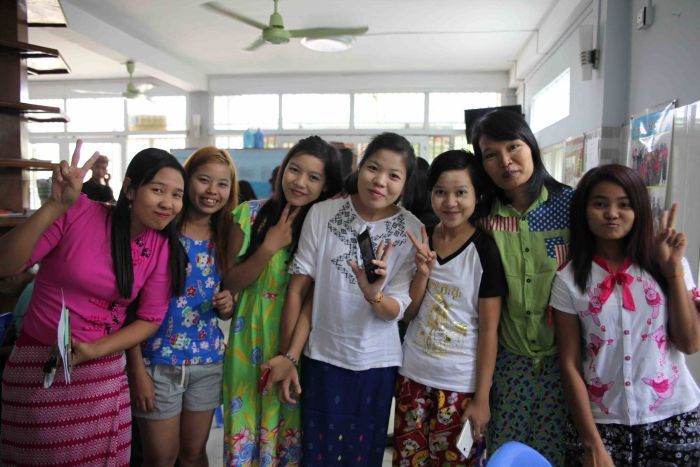
Than Dar Ko runs workshops on workers’ rights for women in Hlaing Tharyar industrial zone in Myanmar. (ABC News: Libby Hogan)
The fundamental rights of women to and at work are essential for realizing other human rights and form an inseparable and inherent part of human dignity. Framing them within the one dimensional context of economic production and consumption ignores the obligations of states to implement the full range of human rights.
Some of the factors behind the current mistreatment and enslavement of women workers include
- Deep-rooted patriarchy
- Discriminatory stereotypes
- Failure of state and non-state actors to recognize the spectrum of what constitutes women’s work
- Pervasiveness of exploitative business models and practices
Structural inequalities and multiple forms of discrimination in law and in practice consistently challenge women’s human rights by perpetuating exploitative labour systems, which manifest in low wages and poor working conditions, discrimination and sexual harassment in the workplace. They also make it challenging and in many cases impossible for women to create and enforce the conditions that enable decent working conditions and social and political transformation toward a more just and equal society.
The principles of substantive equality and non-discrimination, as reflected in the United Nations Convention on the Elimination of All Forms of Discrimination against Women (CEDAW) and the International Covenant on Economic, Social and Cultural Rights (ICESCR), are essential to ensuring that women’s right to and at work are not co-opted or exploited by any economic model, social structure or gender stereotype.
Despite having international human rights instruments in place, women are overrepresented in exploitative and precarious employment such as at the bottom of garment sector supply chains, or domestic work. The perpetrators of human rights abuses continue to evade accountability and thus, there is a need to focus greater attention on the violations of women’s rights to and at work. State and non-state actors (e.g. business actors) must be held accountable for the rights of women workers, especially for violations of the rights of those in vulnerable employment, the informal economy and care and domestic work.
In the lead up to a regional consultation on women’s labour rights being organized by IWRAW Asia Pacific from 18-20 May 2018, we are highlighting 9 articles and resources that shed light on the rights of women to and at work, instances of violations of these rights across the world, and how such violations are challenged, with varying levels of success.
1. Myanmar: garment workers face sexual harassment and pregnancy-related discrimination
Women garment workers face sexual harassment on the way to and from work; and within their work spaces. Often, they also have to undergo pregnancy tests to secure their employment and employers are resistant in paying workers their maternity leave entitlements.
2. Sri Lanka: domestic workers forced to take contraceptives by recruitment agencies
Migrant domestic workers face human rights violations that begin before their arrival in their destination country. Recruitment agencies in Sri Lanka for example, are forcing domestic workers that will migrate to the Middle East to take birth control before they travel.
3. Glass cliff theory on women in the corporate space
Research shows that for the few women in corporate leadership positions, they are often burdened with unsolvable work problems and are still held personally accountable for failing to address them, which perpetuates the gender stereotyped theory that women are unsuitable for leadership positions.
4. Zimbabwe: health and safety conditions on Tobacco farms
Workers on tobacco farms in Zimbabwe are not told about the health and safety implications of handling tobacco, and how to protect themselves in the course of their work. They have to pay for their own gloves and face inequitable work conditions, Yet workers are expected to abide by a company’s social responsibility guidelines while the company is not held accountable for the human rights abuses on the tobacco farms.
5. Laos: minimum wage increase
The current business model depends on low wages for profit, and this disproportionately impacts women who make up a large part of the labour force. However, despite opposition by business owners that increasing the minimum wage would be disastrous for profitability and growth, Laos has agreed to increase the minimum wage. While the minimum wage is still not a living wage, this development signifies some progress for workers in Laos.
6. UN AIDS Reopens Sexual Harassment Case Amidst Criticism
How are the rights of women to and at work are upheld within human rights organizations? Investigations against sexual harassment within UN AIDS were called “shockingly biased and corrupted” by the Code Blue campaign, which aims to end impunity for sexual exploitation and abuse by UN personnel.
7. USA: 7 Sex Workers on What It Means to Lose Backpage
In April 2018 the US Department of Justice seized backpage.com, a website that was frequently used by sex workers as an online marketplace. In this article, sex workers from across the country share how the shutdown has affected their right to work.
8. China: Tech firms apologise after damning report on sexist adverts
A recent report by Human Rights Watch indicates that sexist recruitment practices including “men only” job advertisements by government agencies, tech corporations, etc. have contributed to a decrease in the proportion of women working.
9. Put Women Workers’ Rights on the Agenda
Given that gendered inequalities translate into women workers being more likely to experience violence, have short-term contracts, lower wages, less benefits, less social protection and less likely to access justice that upholds their dignity, it is time to put women workers’ rights on the agenda.
IWRAW Asia Pacific is organizing a Regional Consultation on Women’s Labour Rights in Kathmandu, Nepal from 18-20 May 2018. The aim of the Consultation is to examine the status of CEDAW implementation in South and Southeast Asia through the constructive engagement of women’s rights organizations, human rights experts, state agencies and national human rights institutions (NHRIs) and exploring the opportunities and strategies to advance the implementation of CEDAW and ICESCR, particularly focusing in the context of women’s labour rights.

